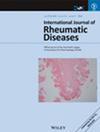Organ Damage and Associated Factors in Chinese Patients With Systemic Lupus Erythematosus
Abstract
Objective
To explore organ damages and factors associated with the occurrence of organ damages in Chinese patients with systemic lupus erythematosus (SLE).
Methods
A cross-sectional study was performed in SLE patients with a disease duration of over 6 months at enrollment. The demographics, clinical characteristics, and medication history were collected. The profile of organ damage measured by the SLE damage index (SDI) at enrollment was displayed. The factors associated with the occurrence of organ damage were analyzed by logistic regression analysis.
Results
Three hundred and fifty patients were enrolled in this study. Their mean age was 38.8 ± 13.1 years, and the median disease duration was 7.0 (2.0, 14.0) years. There were 124 (35.5%) patients with organ damage at enrollment. The damage was most frequently located in ocular (12.8%), followed by musculoskeletal (9.4%), gonads (5.7%), neuropsychiatric (4.8%), and lungs (4.6%). The top five prevalent manifestations were cataract (10.5%), avascular osteonecrosis (6.5%), premature gonadal failure (5.7%), pulmonary hypertension (3.4%) and chronic alopecia (3.4%). In logistic analysis, age (OR = 1.06, 95% CI 1.03, 1.08, p < 0.001), disease duration (OR = 1.09, 95% CI 1.05, 1.13, p < 0.001), current/past use of mycophenolate (OR = 2.66, 95% CI 1.49, 4.75, p = 0.001), SLE disease activity index 2000 (SLEDAI-2K) at enrollment (OR = 1.06, 95% CI 1.00, 1.11, p = 0.035) were independent risk factors of organ damage, while current/past use of hydroxychloroquine (OR = 0.20, 95% CI 0.06, 0.66, p = 0.009) was an independent protective factor.
Conclusion
Organ damage is frequent in Chinese SLE patients. Disease duration, SLEDAI-2K at enrollment, and use of mycophenolate were risk factors, while use of hydroxychloroquine was a protective factor of organ damage. Optimized management is imperative to protect ocular, musculoskeletal, and gonads from damage in clinical practice in the future.

 求助内容:
求助内容: 应助结果提醒方式:
应助结果提醒方式:


